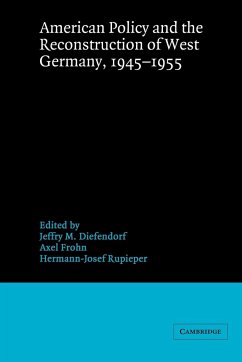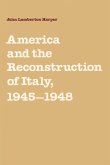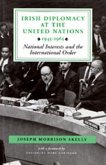This volume of essays by German and American historians discusses key issues of US policy toward Germany in the decade following World War II.
This volume of twenty-three essays by German and American historians deals with the most important issues of US policy toward Germany in the decade following World War II: Germany's democratisation, economic recovery, rearmament, and integration into the European community and Western alliance. All contributions to this volume are based on recent research in German and American archives, and include two comprehensive essays on archival sources and a selected bibliography. In contrast to most other studies, the essays cover not only the period of military government (1945-1949) but also the era of the Allied High Commission for Germany.
Table of content:
1. Introduction Jeffry Diefendorf and Hermann Josef Rupieper; 2. Ripping holes in the Iron Curtain: the council of foreign relations and Germany, 1945-1950 Michael Wala; 3. US policy on a West German constitution Erich J. Hahn; 4. American policy toward German unification, 19490-1955 Hermann Josef Rupieper; 5. Marshall Plan and currency reform Christopher Buchheim; 6. American policy toward Germany and the integration of Europe, 1945-1955 Gunther Mai; 7. From Morgenthau Plan to Schuman Plan: America and the organization of Europe John Gillingham; 8. Return to normality: the United States and the Ruhr industry, 1945-1955 Werner Buhrer; 9. West German agriculture and the European recovery program, 1948-1952 Ulrich Kluge; 10. Science and technology in Postwar Germany John Gimbel; 11. American decentralization policy in the Ruhr coal industry Albert Diegmann; 12. Technology transfer and the emergence of the West German petrochemical industry, 1945-1955 Raymond G. Stokes; 13. A free university of Berlin: a German experiment in higher education, 1948-1961 James F. Trent; 14. Higgs and the unions in West Germany: a study of HICOG's labor policy toward Deutscher Gewerksschaftsbund (DGB), 1949-1952 Michael Fichter; 15. US military occupation, grass roots democracy, and local German government Rebecca Boehling; 16. German democratization as conservative restabilization: the impact of American policy Diethelm Prowe; 17. America and the rebuilding of urban Germany Jeffry Diefendorf; 18. US policy toward German veterans, 1945-1950 James M. Diehl; 19. Grand illusions: the US, the Federal Republic of Germany, and the European defense community, 1950-1954 David C. Large; 20. The Federal Republic of Germany as a 'battlefield' in American Nuclear Strategy, 1953-1955; 21. The presence of American troops in Germany and German American relations, 1949-1956 Bruno Thoss; 22. John J. McCloy and the Landsberg cases Thomas Allen Schwartz; 23. Sources in German archives on the history of American policy toward Germany, 1945-1955 Josef Henke; 24. US High Commissioner for Germany and related records: sources for he history of the Bundesrepublik Deutschland, 1949-1955 in the US National Archives and Records Administration Robert Wolfe.
This volume of twenty-three essays by German and American historians deals with the most important issues of US policy toward Germany in the decade following World War II: Germany's democratisation, economic recovery, rearmament, and integration into the European community and Western alliance. All contributions to this volume are based on recent research in German and American archives, and include two comprehensive essays on archival sources and a selected bibliography. In contrast to most other studies, the essays cover not only the period of military government (1945-1949) but also the era of the Allied High Commission for Germany.
Table of content:
1. Introduction Jeffry Diefendorf and Hermann Josef Rupieper; 2. Ripping holes in the Iron Curtain: the council of foreign relations and Germany, 1945-1950 Michael Wala; 3. US policy on a West German constitution Erich J. Hahn; 4. American policy toward German unification, 19490-1955 Hermann Josef Rupieper; 5. Marshall Plan and currency reform Christopher Buchheim; 6. American policy toward Germany and the integration of Europe, 1945-1955 Gunther Mai; 7. From Morgenthau Plan to Schuman Plan: America and the organization of Europe John Gillingham; 8. Return to normality: the United States and the Ruhr industry, 1945-1955 Werner Buhrer; 9. West German agriculture and the European recovery program, 1948-1952 Ulrich Kluge; 10. Science and technology in Postwar Germany John Gimbel; 11. American decentralization policy in the Ruhr coal industry Albert Diegmann; 12. Technology transfer and the emergence of the West German petrochemical industry, 1945-1955 Raymond G. Stokes; 13. A free university of Berlin: a German experiment in higher education, 1948-1961 James F. Trent; 14. Higgs and the unions in West Germany: a study of HICOG's labor policy toward Deutscher Gewerksschaftsbund (DGB), 1949-1952 Michael Fichter; 15. US military occupation, grass roots democracy, and local German government Rebecca Boehling; 16. German democratization as conservative restabilization: the impact of American policy Diethelm Prowe; 17. America and the rebuilding of urban Germany Jeffry Diefendorf; 18. US policy toward German veterans, 1945-1950 James M. Diehl; 19. Grand illusions: the US, the Federal Republic of Germany, and the European defense community, 1950-1954 David C. Large; 20. The Federal Republic of Germany as a 'battlefield' in American Nuclear Strategy, 1953-1955; 21. The presence of American troops in Germany and German American relations, 1949-1956 Bruno Thoss; 22. John J. McCloy and the Landsberg cases Thomas Allen Schwartz; 23. Sources in German archives on the history of American policy toward Germany, 1945-1955 Josef Henke; 24. US High Commissioner for Germany and related records: sources for he history of the Bundesrepublik Deutschland, 1949-1955 in the US National Archives and Records Administration Robert Wolfe.








